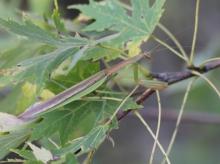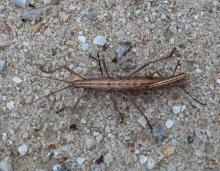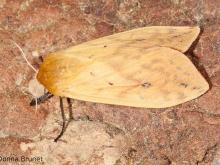Land Invertebrates
Media

Species Types
Scientific Name
Tenodera sinensis (formerly T. aridifolia)
Description
The Chinese mantis is a large, green and tan ambush predator. This nonnative insect is often called a “praying mantis” because the front legs resemble hands folded in prayer.
Media

Species Types
Scientific Name
Anisomorpha ferruginea
Description
Be careful when approaching northern two-striped walkingsticks: They can squirt an acrid fluid at you. Musk mare, devil’s riding horse, and prairie alligator are all names for this remarkable stick insect.
Media

Species Types
Scientific Name
Stagomantis carolina, Mantis religiosa, and Tenodera sinensis
Description
Most people recognize mantids, or mantises, when they see them, but it takes more practice to distinguish among the different species of these efficient insect predators.
See Also



Media

Species Types
Scientific Name
Cisseps fulvicollis
Description
The yellow-collared scape moth is more often “orange-collared.” And whether you think it looks more like a firefly or a wasp, it’s still a moth!
Media

Species Types
Scientific Name
Nearly 150 species in North America north of Mexico
Description
Slim, delicate plume moths are instantly recognizable by their T-shaped silhouette, long legs, and muted shades of tan and brown. It can be hard to separate the various species.
Media

Species Types
Scientific Name
Pyrrharctia isabella
Description
Not many people know the adult Isabella tiger moth when they see one, but we’re all acquainted with its caterpillar, the woolly worm, or woolly bear.
About Land Invertebrates in Missouri
Invertebrates are animals without backbones, including earthworms, slugs, snails, and arthropods. Arthropods—invertebrates with “jointed legs” — are a group of invertebrates that includes crayfish, shrimp, millipedes, centipedes, mites, spiders, and insects. There may be as many as 10 million species of insects alive on earth today, and they probably constitute more than 90 percent all animal species.





















